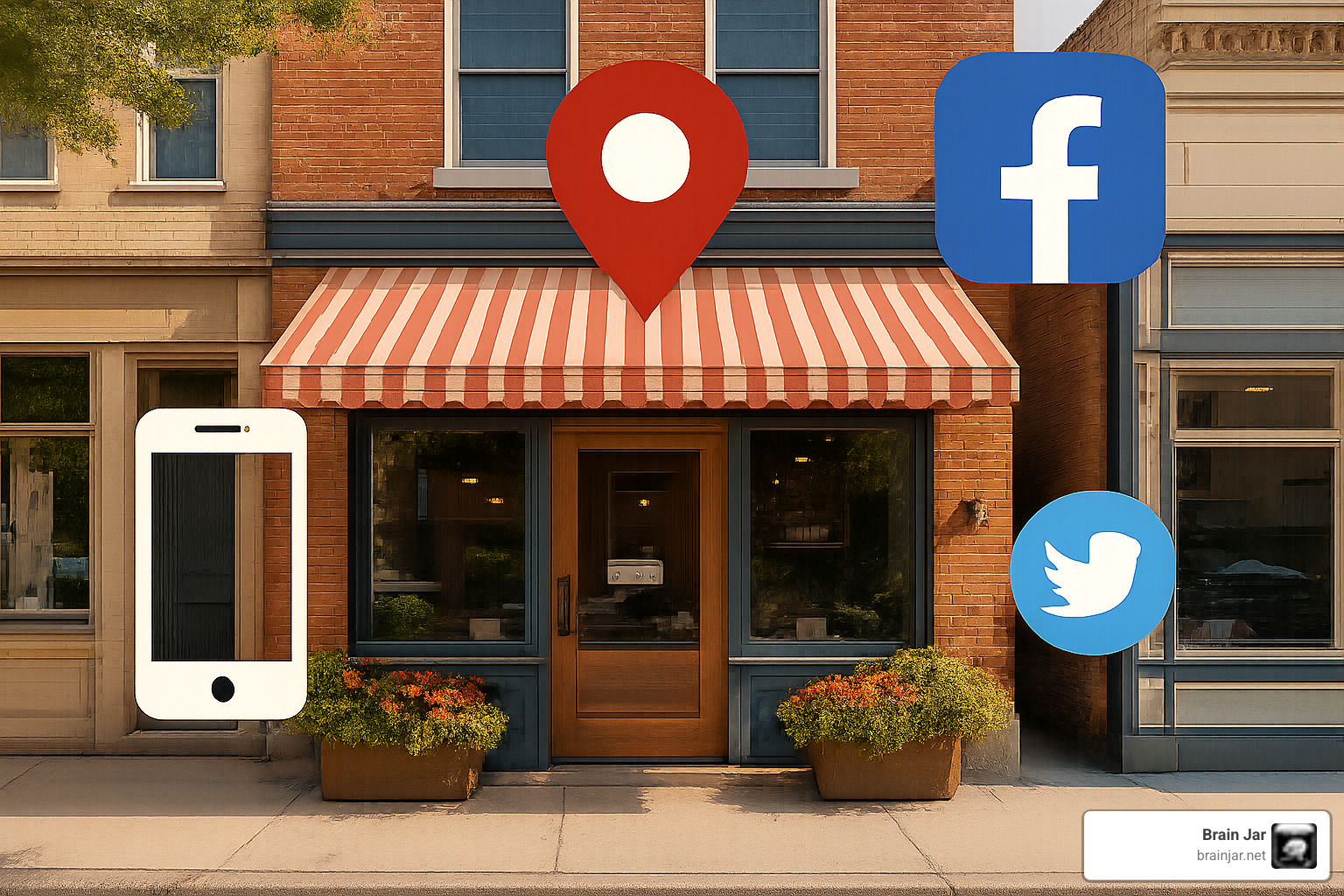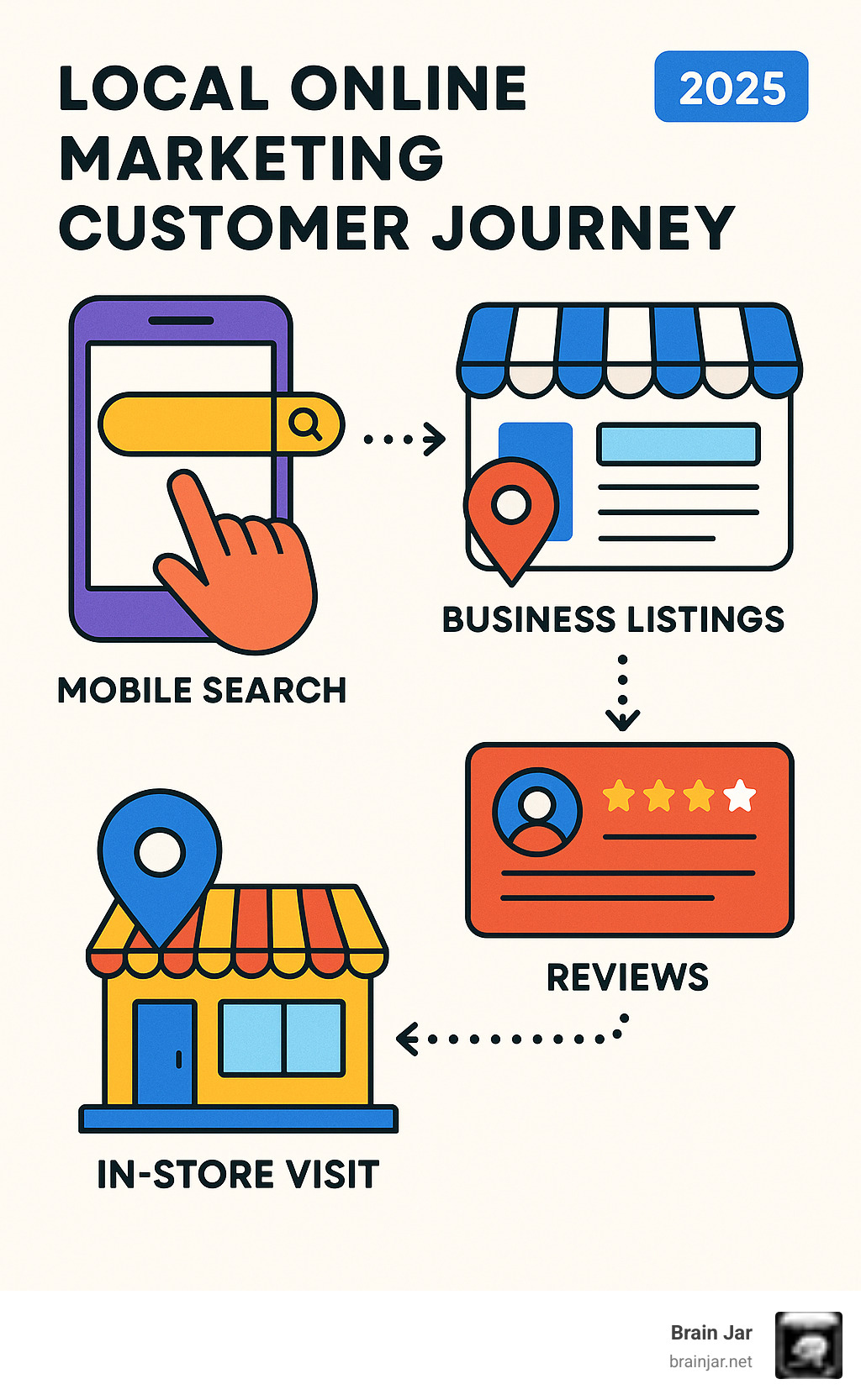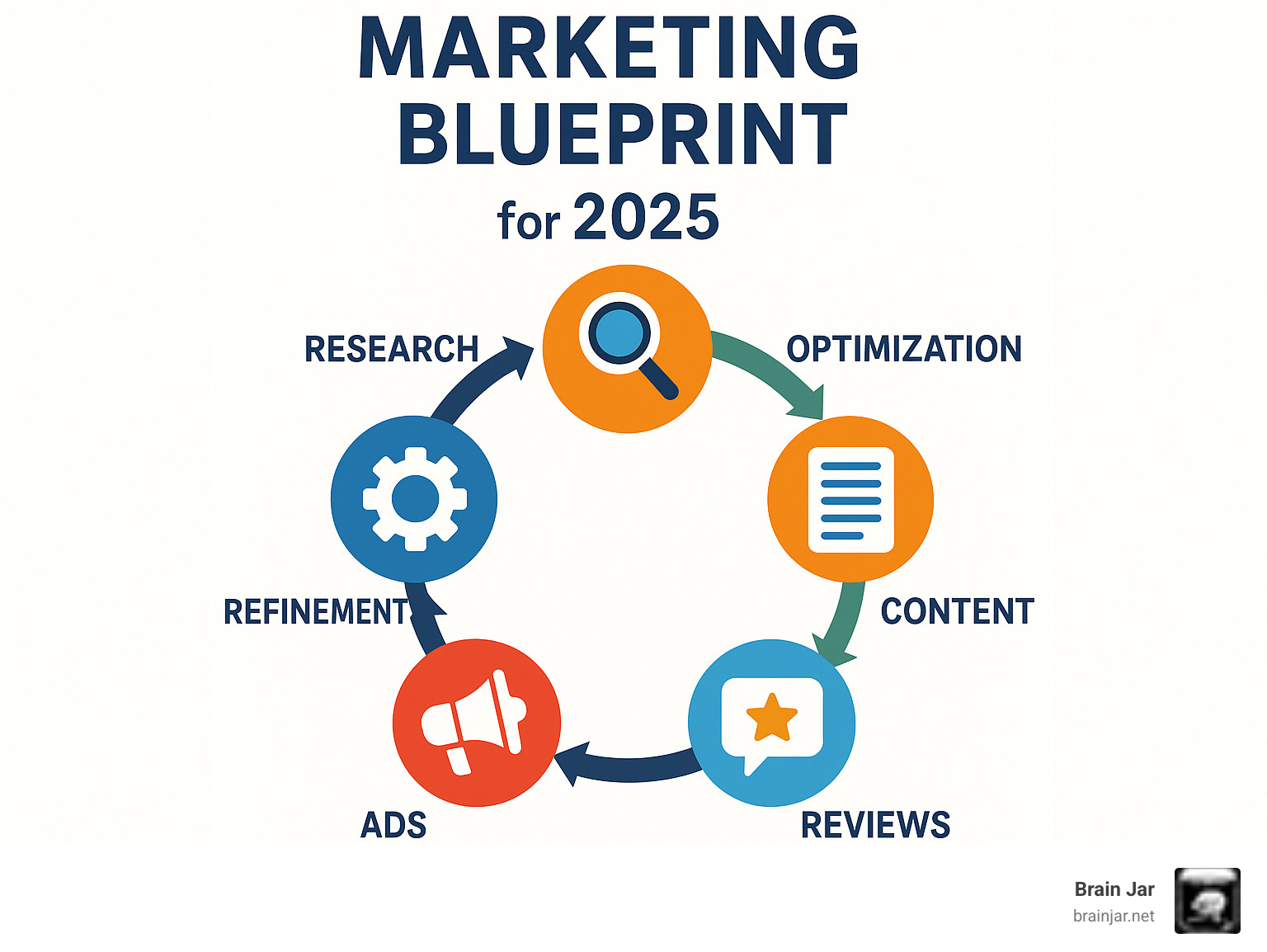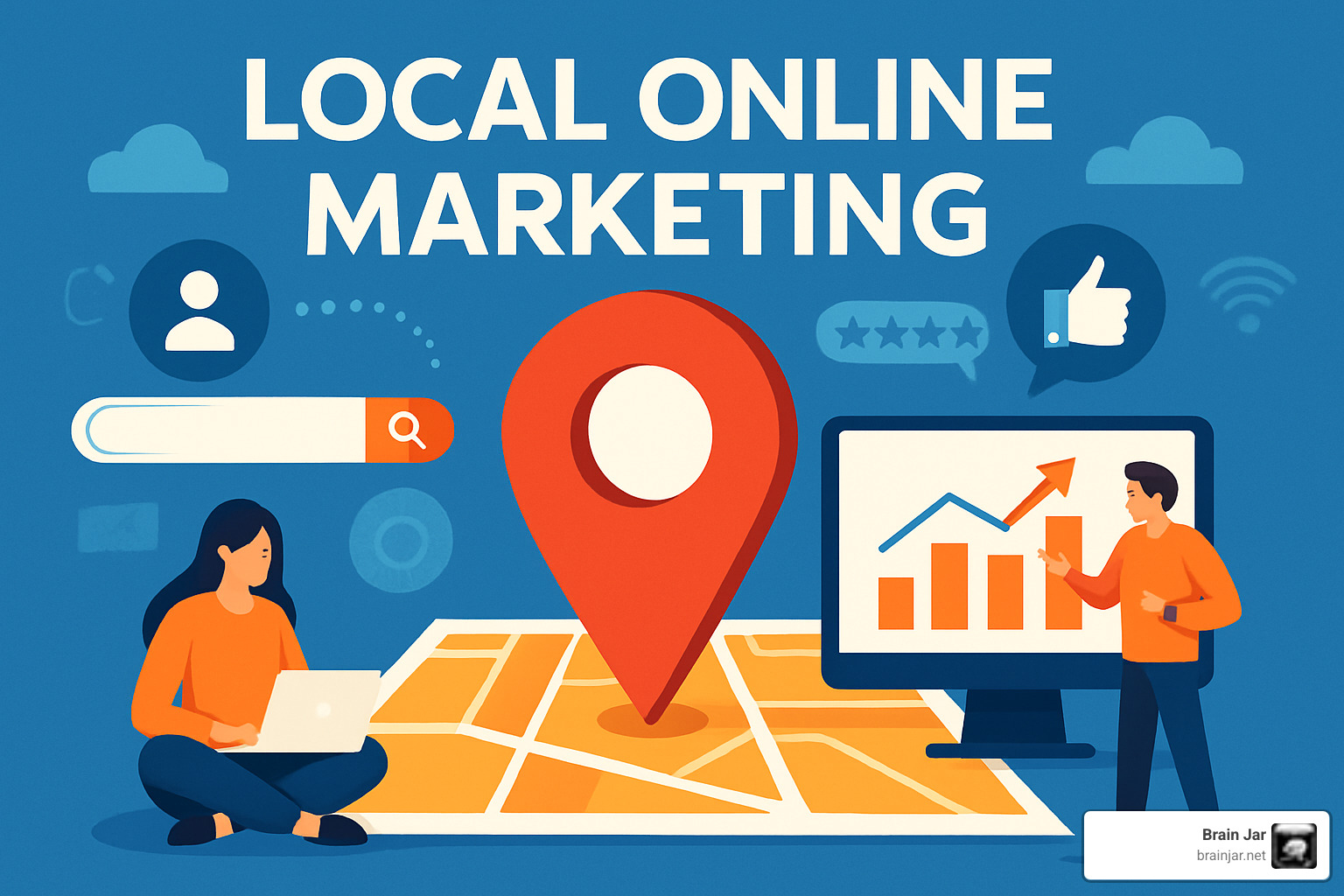Why Local Online Marketing is Essential for Small Business Success

Local online marketing is the process of promoting your business to nearby customers through digital channels like search engines, online directories, and social media platforms. Here’s what it includes:
Core Components:
- Local SEO – Optimizing your website and Google Business Profile for “near me” searches
- Online Directory Listings – Claiming profiles on Google, Yelp, and other local platforms
- Reputation Management – Monitoring and responding to customer reviews
- Geo-Targeted Advertising – Running ads that only show to people in your service area
- Social Media Marketing – Engaging with your local community on platforms like Facebook and Instagram
The numbers tell a compelling story. Research shows that 88% of consumers shop locally once a week, and 90% of purchases occur within 15 miles from a consumer’s home or office. Even more striking: 76% of customers who search for a local business will visit that business within 24 hours.
Traditional marketing methods like direct mail still work – accounting for 22.7% of local ad revenue. But online local advertising comes in second at 17% and continues to grow rapidly. With 46% of Google searches looking for local results and 92% of consumers reading online reviews before making decisions, having a strong local online presence isn’t optional anymore.
I’m HJ Matthews, Business Development Manager at Brain Jar, and over my 15 years in digital marketing, I’ve helped businesses across industries from construction to automotive leverage local online marketing to drive measurable growth.

What Is Local Online Marketing?
Local online marketing is your digital neighborhood presence. It’s how you show up when someone nearby searches for exactly what you offer. Instead of shouting into the void with traditional ads, you’re having targeted conversations with people who are already looking for your services.
The magic happens when someone types “coffee shop near me” or “plumber in Riverside” into their phone. Local online marketing ensures your business appears in those crucial moments when potential customers are ready to act.
Local SEO forms the backbone of this strategy. It’s about making your website and Google Business Profile irresistible to search engines when they’re deciding which local businesses to recommend. This means weaving location-specific keywords naturally throughout your site, keeping your business information consistent everywhere it appears online, and building up those precious positive reviews.
Your Google Business Profile deserves special attention – it’s essentially your digital storefront window. When 97% of consumers use the internet when researching local products and services, this profile often creates their first impression of your business.
Online directories like Yelp, Apple Maps, and industry-specific platforms create a web of credibility signals. Each listing acts like a digital breadcrumb that search engines follow to verify your business is legitimate and trustworthy.
Here’s what makes local marketing so powerful: the conversion funnel moves incredibly fast. Unlike traditional e-commerce where customers might browse for weeks, local shoppers often go from search to store visit within hours.
Local Online Marketing vs Traditional Ads
The difference between local online marketing and traditional advertising is like comparing a sniper rifle to a shotgun. Traditional methods spray your message everywhere, hoping someone interested will notice. Digital local marketing targets people who are already raising their hands saying “I need this service.”
Let’s talk dollars and cents. A direct mail campaign might cost you $1-3 per piece with response rates hovering around 1-3%. Geo-targeted PPC campaigns might cost $10-50 per click, but conversion rates for local searches often hit 15-20% because you’re reaching people with genuine intent.
The real game-changer is real-time analytics. Traditional ads leave you playing guessing games. Digital campaigns tell you everything: which keywords brought visitors, what ads generated phone calls, and which landing pages turned browsers into buyers.
Radius targeting gives you surgical precision that traditional media can’t match. You can focus on customers within 1-5 miles of your location, adjust your bids based on distance, and exclude areas where you don’t provide service.
“Near me” searches have exploded 34× since 2011, and over 50% of these searches result in actual store visits. While phone books gather dust, mobile phones are directing customers to your door.
Local Online Marketing Tech Stack Basics
Building your local online marketing foundation doesn’t require a computer science degree, but you do need the right tools working together. Your website serves as mission control, typically built on user-friendly platforms like WordPress, Squarespace, or Shopify.
Citation management tools solve one of local marketing’s biggest headaches: keeping your business information consistent across hundreds of online directories. These platforms automatically sync your name, address, and phone number (NAP) across major listings.
Review platforms bring order to the chaos of managing your online reputation. Instead of jumping between Google, Yelp, Facebook, and dozens of other sites, these tools create unified dashboards where you can monitor all feedback and respond quickly.
Ad management dashboards centralize your Google Ads, Facebook campaigns, and other paid efforts. Advanced platforms include call tracking features that assign unique phone numbers to different campaigns.
Analytics suites go far beyond basic Google Analytics to provide insights that matter for local businesses. They track store visits, direction requests, and phone calls generated from online searches.
Local Online Marketing Essentials for 2025
The local online marketing world is changing fast, and what worked last year might not cut it in 2025. The biggest game-changer? AI-driven personalization that lets you create campaigns that actually speak to each customer’s unique needs and local preferences.
Voice search has completely transformed how people find local businesses. Instead of typing “pizza restaurant,” people now ask their phones “Where’s the best pizza near me?” This shift means your content needs to sound conversational and answer the questions people actually ask out loud.
The magic is in hyper-local keywords. Forget trying to rank for “restaurant” – you want to own phrases like “best breakfast burrito in downtown Phoenix” or “late-night coffee shop near ASU.” These specific terms have less competition and attract customers who are ready to visit your business today.
Here’s something that can’t be ignored: mobile page speed. When someone searches for a local business on their phone, they expect your site to load instantly. Research shows that mobile conversion rates drop significantly with even small delays. Google knows this too – your mobile site performance directly affects your search rankings.
Schema markup might sound technical, but it’s basically a way to help search engines understand your business better. Think of it as giving Google a clear instruction manual about your hours, location, and services.
Modern local online marketing uses AI platforms that can predict busy seasons, automatically respond to reviews, and even send personalized emails based on where customers live and what they’ve bought before.
Core Benefits Small Businesses Love
Local online marketing gives small businesses superpowers they never had before. The focused reach means you can dominate your neighborhood instead of getting lost in the noise of national advertising. Your local pizza shop can outrank Pizza Hut in local searches.
Budget control changes everything. You can start with just $10 a day, see what works, and gradually increase spending on the campaigns that bring in customers. No more gambling on expensive newspaper ads and hoping for the best.
The measurable ROI transforms marketing from guesswork into science. You’ll know exactly how many customers found you through Google, which Facebook posts drove the most calls, and what your actual cost per customer looks like.
Stronger community ties develop naturally when you’re active in local online spaces. Responding to reviews, sharing local events, and engaging with customers on social media builds relationships that go way beyond a single purchase.
Partnership opportunities pop up more often when other local businesses can easily find you online. That coffee shop might find your bakery through Instagram and want to cross-promote.
The best part? You can compete with big corporations on equal footing. A well-optimized local business can outrank national chains in local search results.
Building a Local Online Marketing Strategy

Building a successful local online marketing strategy starts with understanding your local landscape. Market research reveals what your competitors are doing, which keywords your customers actually use, and how people in your area search for businesses like yours.
Keyword planning goes beyond basic tools – you need to think like your customers. Use Google’s Keyword Planner to find location-specific terms, but also pay attention to the questions people ask.
NAP consistency – your business name, address, and phone number – must be identical everywhere online. This sounds simple, but it’s where many businesses stumble.
Content calendars keep you connected to your community year-round. Plan posts around local events, seasonal trends, and community happenings.
Reputation management requires both monitoring and action. Set up alerts for new reviews, create thoughtful response templates, and develop systems for encouraging happy customers to share their experiences. 88% of consumers trust online reviews as much as personal recommendations.
Analytics and refinement turn your strategy into a continuous improvement process. Track local search rankings, website traffic from nearby searches, phone calls generated, and actual customer conversions.
Product Roundup: Best Solutions by Goal
When it comes to local online marketing, having the right tools can make the difference between spinning your wheels and actually driving customers through your door. Let me walk you through the essential tools that can transform your local marketing efforts.
Website & SEO Optimizers
Your website is the foundation of everything else you’ll do in local online marketing. If it’s slow, confusing, or doesn’t show up in search results, you’re fighting an uphill battle from day one.
Site speed tools should be your first stop. When someone searches for “pizza near me” at 7 PM on a Friday, they’re not going to wait around for your website to load. These tools identify exactly what’s slowing down your site and give you actionable steps to fix it.
Schema markup might sound technical, but it’s basically a way to help Google understand what your business actually does. Schema generators create the code that tells search engines “this is a restaurant, here are the hours, here’s the phone number.”
On-page SEO checkers act like a personal trainer for your website. They scan your pages and point out missed opportunities: “Your title tag doesn’t mention your city,” or “You forgot to include your address in the footer.”
If your website feels sluggish, you’re not alone. Why Is My Website Loading So Slowly? This is especially critical for local searches, where customers expect instant results.
Listings & Reputation Managers
Managing your business listings across dozens of directories used to be a nightmare. Citation management platforms changed that by automating the whole process. They push your business information to Google, Yelp, Apple Maps, and hundreds of other sites.
Getting reviews shouldn’t feel like begging. Review request automation systems send perfectly timed requests to customers when they’re most likely to respond positively.
Sentiment analysis dashboards take the guesswork out of reputation management. Instead of manually reading through hundreds of reviews, these tools categorize feedback by emotion and topic.
Response management tools ensure no review goes unanswered. They provide templates for common situations and help you maintain a consistent voice across all platforms.
Learning how to respond effectively can turn negative reviews into positive outcomes. Responding to reviews properly shows future customers that you’re committed to excellent service.
Paid Ads & Lead Gen Platforms

Geo-targeted PPC platforms give you surgical precision in reaching nearby customers. You can draw circles around your service area, bid more aggressively for customers within five miles, and completely exclude areas you don’t serve.
Google Local Services Ads operate on a pay-per-lead model that’s perfect for service businesses. These ads appear above regular search results and include the Google Guarantee badge, which builds instant trust with potential customers.
Social media advertising managers help you tap into the local community on Facebook and Instagram. They can create lookalike audiences based on your existing customers’ locations and demographics.
Call tracking systems solve the age-old problem of “I know half my advertising works, I just don’t know which half.” They assign unique phone numbers to different campaigns, so you know exactly which ads are driving actual phone calls.
Understanding the mechanics behind ad performance helps you get better results for less money. Ad ranking tips from Google explain how to improve your Quality Score and reduce your cost-per-click.
Social Media & Content Creators
Social media scheduling tools designed for local businesses understand that your content needs to connect with your immediate community. They suggest local hashtags, help you tag your location consistently, and can even integrate with local event calendars.
Location-based content creation tools help you tap into what’s happening in your area. They track local trends, seasonal patterns, and community events that your audience cares about.
User-generated content platforms turn your customers into your marketing team. They make it easy to run photo contests, encourage hashtag campaigns, and showcase customer experiences.
Local hashtag research tools help you find the tags that actually work in your area. Generic hashtags like #restaurant get lost in the noise, but #downtownriversideeats might connect you directly with your ideal customers.
Content creation becomes more strategic when you understand what resonates with local audiences. Why Are Social Media Posts About Food So Popular? This insight helps restaurants and food-related businesses create content that naturally generates engagement.
Analytics & All-in-One Dashboards
Comprehensive analytics platforms go beyond basic website traffic to track what really matters for local businesses. They monitor store visits generated from online searches, phone calls from digital campaigns, and direction requests from map listings.
Multi-channel reporting tools eliminate the headache of logging into five different platforms to see how you’re doing. They pull data from your website, social media accounts, review platforms, and advertising campaigns into one unified dashboard.
Phone call analytics platforms use AI to transcribe and analyze customer calls, revealing insights about lead quality and common questions.
Zip-code level reporting helps you understand performance variations across your service area. You might find that customers from certain neighborhoods have higher lifetime values or that your ads perform better in specific parts of town.
AI-powered insights platforms analyze all your local marketing data to identify trends and predict seasonal patterns. They can automatically adjust campaigns based on performance data and market conditions.
Frequently Asked Questions about Local Online Marketing
How fast can local online marketing drive foot traffic?
The speed at which local online marketing can drive customers to your door often surprises business owners. Unlike traditional advertising that might take weeks or months to show results, local digital marketing can start bringing people through your doors within days.
The numbers tell an encouraging story. 57% of users contact a business they found on Yelp within one day, and over 50% of “near me” searches result in a store visit. This means when someone searches for your type of business, there’s a good chance they’ll be walking through your door soon.
If you’re starting completely fresh, claiming and optimizing your Google Business Profile typically shows results within 2-4 weeks. But businesses that already have some online presence often see improvements within days of implementing proper local SEO strategies.
For the fastest results, paid advertising is your best friend. Google Local Services Ads and geo-targeted PPC campaigns can have your phone ringing within hours of going live.
The secret sauce is understanding that people searching locally are ready to buy. When someone types “plumber near me” or “pizza delivery,” they’re not just browsing – they need help now.
Do I need a website if I’m listed on Google and Yelp?
This is one of the most common questions I hear, and I get why business owners ask it. Your Google Business Profile and Yelp listing do provide real value, but thinking of them as replacements for a website is like thinking a business card can replace a storefront.
Your website is the one place online where you have complete control. Google and Yelp give you limited space and format options, but your website lets you tell your full story. You can showcase your work, explain your process, and really connect with potential customers.
Search engines also use your website content to understand what you do and when to show your business in search results. Without a website, you’re stuck with the basic information fields on directory platforms.
There’s also the credibility factor. 36% of respondents say a clear and smart website increases local business credibility. When people are choosing between businesses, the one with a professional website often wins.
Your website also enables features that can actually convert visitors into customers – things like online booking, detailed service descriptions, photo galleries, and easy contact forms.
The good news? Your website doesn’t need to be fancy. A simple, mobile-friendly site with clear contact information, service descriptions, and some customer testimonials can be incredibly effective.
How do online reviews influence local search rankings?
Online reviews are like digital word-of-mouth that search engines can actually read and understand. Google pays close attention to your reviews when deciding where to rank your business in local search results, and the impact is significant.
The relationship between reviews and rankings works in several ways. Google looks at how many reviews you have, what ratings you’re getting, and how recent those reviews are. Businesses with more positive reviews typically rank higher than competitors with fewer or lower-rated reviews.
The trust factor is huge here. 88% of consumers trust online reviews as much as personal recommendations, and Google’s algorithm recognizes this. When search engines see that real people are having positive experiences with your business, they’re more likely to show your business to other potential customers.
Fresh reviews matter too. Google likes to see that you’re actively serving customers and earning new feedback. Businesses that consistently get new reviews signal to search engines that they’re busy and doing good work.
But here’s something many business owners miss – responding to reviews also affects your rankings. When you take the time to respond to customer feedback, you’re showing both Google and potential customers that you care about the experience you provide.
Conclusion
The journey through local online marketing reveals a fundamental truth: small businesses have never had better tools to compete for their local customers’ attention. When nearly half of all Google searches seek local results and the vast majority of consumers read reviews before making decisions, your digital presence becomes your most powerful business asset.
Think of local online marketing as building bridges between your business and your community. Each optimized Google Business Profile, every thoughtful review response, and all those carefully crafted social media posts create pathways for customers to find and choose you. The technology tools we’ve explored work together to create a web of credibility that search engines and customers both recognize.
Starting can feel overwhelming, but every successful local business began with a single step. Maybe it’s claiming your Google Business Profile today, or responding to that review you’ve been putting off. The customers in your community are already searching – they’re just waiting for you to make it easy for them to find you.
The landscape keeps evolving with AI personalization and voice search, but the core principle remains unchanged: serve your community genuinely, and the technology will amplify your efforts. When you focus on solving real problems for real people in your area, the technical aspects become tools that help you do what you already do best.
At Brain Jar, we’ve seen countless local businesses transform their customer acquisition by embracing these digital strategies. From family restaurants finding the power of online reviews to service companies learning to dominate “near me” searches, the results speak for themselves. We help businesses across Riverside and Southern California turn their local online presence into a customer magnet through web development, SEO, social media management, and targeted advertising.
Your community needs what you offer. Local online marketing simply ensures they can find you when they’re ready to buy. Whether you’re taking your first steps or refining an existing strategy, every interaction online is an opportunity to build the kind of business relationship that lasts.
For businesses ready to master systematic customer outreach, more info about outreach masterclass can help you develop comprehensive approaches to building lasting customer relationships.
The goal isn’t just higher search rankings or more website traffic – it’s creating a thriving local business that becomes an integral part of your community’s fabric. When you achieve that, the clicks naturally turn into customers, and those customers become the foundation of sustainable growth.
